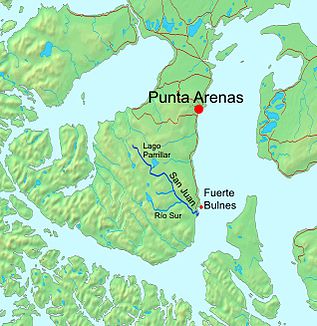Río San Juan de la Posesión
|
Río San Juan de la Posesión (short: Río San Juan; in the 18th to the beginning of the 20th century also called Río Sedger) |
||
| Data | ||
| location |
|
|
| origin | By confluence | |
| muzzle | Bahía San Juan Coordinates: 53 ° 39 ′ 0 ″ S , 70 ° 56 ′ 30 ″ W 53 ° 39 ′ 0 ″ S , 70 ° 56 ′ 30 ″ W. |
|
| Mouth height |
0 m
|
|
| length | 60 km | |
| Catchment area | 860 km² | |
| Discharge at the Desembocadura gauge 9–30 m³ / s A Eo : 870 km² Location: 4 km above the mouth |
MQ 1970/2009 Mq 1970/2009 |
17.79 m³ / s 20.4 l / (s km²) |
| Left tributaries | Desagüadero River | |
| Right tributaries | Río Sur | |
| Flowing lakes | Lake El Parrillar | |
| Communities | Punta Arenas | |
The Río San Juan de la Posesión is a river in southern Patagonia , in the municipality of Punta Arenas , Chile . Over a length of 60 km it flows through the mostly dense jungle of the Brunswick Peninsula to its mouth on the north coast of the Strait of Magellan .
description
The Río San Juan de la Posesión and its water catchment area are located in the central area of the Brunswick Peninsula in the Magallanes region in Chile , close to the coastal city of Punta Arenas . In terms of the size of its catchment area of 860 km 2 , it is the most important of the local rivers. The average annual rainfall in this area is 800 to 1000 mm. It has its origin in the confluence of two nameless watercourses that come from the north and the northwest. From there it meanders with a width of 10 to 20 meters and a length of almost 60 km from northwest to southeast through the mostly dense jungle to its mouth on the northern coast of the Magellan Strait. The estuary is 55 km south of the city of Punta Arenas.
In the upper water catchment area lies the Laguna Parrillar lake ( 53 ° 24 ′ S , 71 ° 14 ′ W ) which flows into the river via the Desagüadero River. The lake with an area of almost 970 hectares and its immediate surroundings are a popular destination. The water supply for Punta Arenas comes from this lake.
History
In February 1580, Pedro Sarmiento de Gamboa discovered the river for the first time for the Spanish crown, took it formally and received its current name. A few kilometers away from the estuary, at Puerto del Hambre , an attempt was made in 1584 to build a fortress to control shipping traffic through the Strait of Magallan. The company ended in catastrophe with the deaths of almost all soldiers and colonists involved. Several hundred people froze to death or starved to death. The bay into which the river flows was then repeatedly used as an anchorage for seafarers from many nations. There was fresh water, wood and game to be found here. At high tide, small boats could travel up to 15 km upstream.
It is believed that a timber industry first became active in the region in the 1950s. In the 1960s there were forest worker camps for the first time, but no massive settlement. Since the 1980s, an average of 3,247 people have visited Laguna Parrillar each year, between October and April.
Individual evidence
- ↑ a b c d e f Hans Niemeyer Fernández: Hoyas hidrográficas de Chile . 12 a Región de Magallanes y de la Antartica Chilena. Ed .: Ministerio de Obras Públicas. Dirección General de Aguas. Santiago de Chile 1982 ( online [PDF; 23.0 MB ; accessed November 30, 2015]).
- ↑ a b c División de estudios y planicficación Dirección General de Aguas (ed.): Informe técnico N ° 6 Reserva del Río del Oro para la conservación am biental y el desarrollo local de la cuenca . Santiago de Chile October 2009 ( online [PDF; 2.0 MB ; accessed on December 22, 2015]).
- ↑ a b c d e f Claudio Cunazza, Víctor Fernández, Juan Ivanovich, Neftalí Zambrano, Juan López, Carlos Aravena, Gladys Gallardo: Plan de manejo Reserva Nacional Laguna Parrillar . Ed .: Corporación Nacional Forestal, gerencia técnica. ( conaf.cl [PDF; 3.0 MB ; accessed on December 15, 2015]).
- ↑ Pedro Sarmiento de Gamboa, Bartolomé Leonardo de Argensola, Tomé Hernández: Viage al Estrecho de Magallanes por el Capitan Pedro Sarmiento de Gamboa en los años de 1579 y 1580 . Y noticia de la expedicion que despues hizo para poblarle. Ed .: Bernardo de Iriarte. Imprenta Real de la Gazeta, Madrid 1768 (Spanish, limited preview in Google Book Search).
